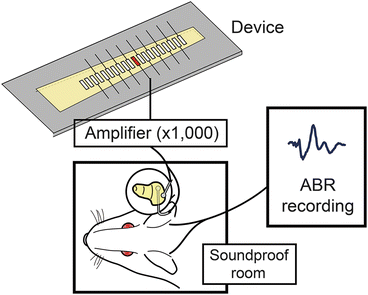The cochlear implant is a hearing device that restores hearing in deafened patients, of which development is worthy for Lascar prize. A stimulator of the cochlear implant, with an array of up to 24 electrodes, is surgically inserted into the cochlea, usually the scala tympani, and directly stimulates auditory primary neurons. Conversion of sound stimuli to electric signals is performed by a speech processor and a transmitter as an external device. According to the development of programs for a speech processor, clinical benefits of cochlear implants have remarkably improved. However, hearing obtained by the cochlear implant is still far from natural hearing. The cochlear implant utilizes the function of remaining spiral ganglion neurons in the cochlea, but does not utilize the mechanical tonotopy of the cochlea, which still remains in deafened cochleae. We have challenged to develop a new auditory device that utilizes the mechanical tonotopy of the cochlea without the use of an external battery (Fig. 17.1). We named this project “technological regeneration of the cochlear sensory epithelium” [4].
17.2 Piezoelectric Materials
Piezoelectric materials can generate the surface charge when it becomes mechanically stressed, and this phenomenon is the so-called piezoelectric effect. The inverse effect, which is the phenomenon that applying the voltage results in the expansion or contraction of the material, is also realized. Quarts, bones, lead zirconate titanate (PZT) and polyvinylidene difluoride (PVDF) are well-known materials which have the piezoelectric effect. Piezoelectric materials can be used for electric power generators and pressure sensors by the use of the direct piezoelectric effect. On the other hand, they can be used for actuators, which convert the input source to the mechanical motion, by the use of the inverse piezoelectric effect. Therefore, the direct piezoelectric effect can be used to generate electricity in response to sound vibration, and the inverse piezoelectric can be utilized as a sensor for sound vibration that might contribute to enhance the sensitivity for sound frequencies.
17.3 Non-Life-Sized Device
Our final goal is to develop a novel artificial cochlea which realizes both acoustic/electric conversion and frequency selectivity without an external energy supply. As the first step, the non-life-sized prototype device was developed for in vitro experiment [5] as shown in (Fig. 17.2) by the use of microelectromechanical systems (MEMS) technologies. The main part of the device comprises an artificial basilar membrane made of piezoelectric material. It is a polyvinylidene difluoride (PVDF) membrane 40 μm thick fixed on a substrate with a trapezoidal slit.
The membrane over the slit is vibrated by acoustic waves and generates electric output due to the piezoelectric effect of PVDF, and the width is linearly varied from 2.0 to 4.0 mm along the longitudinal direction of 30 mm to change its local resonant frequency of O(1)–O(10) kHz. A detecting electrode array with 24 elements of 0.50 × 1.0 mm rectangles is made of an aluminum thin film on the membrane, where they are located along the longitudinal direction with the gaps of 0.50 mm. The resonating place in the membrane vibrates with relatively large amplitude, the electric output there becomes high due to the large strain and the output at the other electrodes remains to be low. As a result, the electric signals from each electrode realize the function of frequency selectivity [5].
By the use of the prototype and non-life-sized piezoelectric device, the experiment of the generation of auditory brainstem responses (ABRs) in living guinea pigs [4] was made as shown in Fig. 17.3. The device was used as a transducer, and its electric outputs were amplified by 1,000-fold. Platinum–iridium ball electrodes were implanted into the scala tympani of the cochlear basal turn for stimulation of auditory primary neurons. As a result, typical ABRs in response to increased acoustic stimuli were recognized in our model animals as shown in Fig. 17.4 [4]. When acoustic stimuli of 104.4 dB sound pressure level (SPL) were applied to the piezoelectric device, the first positive wave of ABRs was clearly identified at a latency of 1.07 ± 0.05 ms, which was identical to the latency of the first positive wave in electrically evoked ABRs (0.98 ± 0.06 ms) in guinea pigs obtained in preliminary experiment as shown in Fig. 17.5 [4]. In normal ABRs, wave I is from the excitation of cells in the spiral ganglion of cochlea and wave II is from the excitation of cochlear nucleus. In general, the first positive wave of electrically evoked ABRs corresponds to wave II of normal ABRs. Compared with the latency of wave II of normal ABRs in normal guinea pigs (n = 4, 2.99 ± 0.11 ms), the latency of the first positive wave of piezoelectric device-induced ABRs was ∼2 ms short as shown in Figs. 17.4 and 17.5 [4]. However, the latency of the first positive wave of piezoelectric device-induced ABRs was almost similar to the latency between waves I and II of normal ABRs (0.83 ± 0.04 ms) shown in Fig. 17.5. From these experimental analyses, it was found that the piezoelectric membrane generated biological ABRs by converting acoustic stimuli to electric signals.





